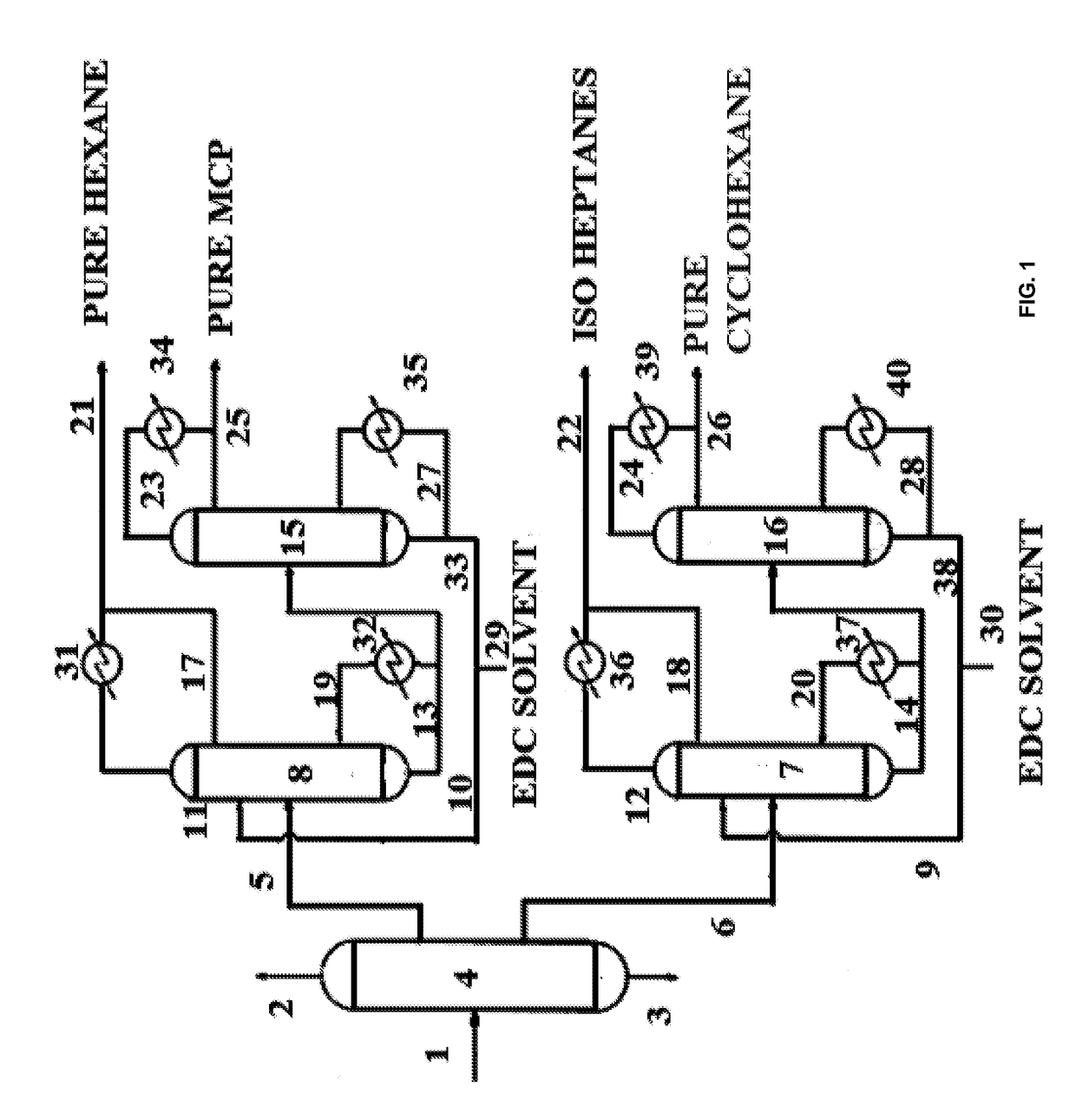Process for high purity hexane and production thereof
a technology of hexane and high purity, applied in the direction of separation process, fractional condensation purification/separation, organic chemistry, etc., can solve the problems of high cost and high process cost, and achieve the effect of high purity
- Summary
- Abstract
- Description
- Claims
- Application Information
AI Technical Summary
Benefits of technology
Problems solved by technology
Method used
Image
Examples
example 1
[0103]Experiments were conducted with hydrocarbon feedstock consisting of hexane and methylcyclopentane with MEG as a solvent. The solvent-to feed ratio was 3 vol / vol. The mixture of solvent and feed were heated to a temperature of 75° C. and the vapors were condensed and completely refluxed back to the solvent feed mixture. After 2 hours of distillation and total reflux, samples of both liquid and condensed vapor were collected and analyzed for composition. The results are summarized in the following table.
LiquidFeedPhaseVapor Phasen-Hexane %69.158.2372.41Methylcyclopentane, %30.941.7727.59
[0104]The separation factor in the above example has been found to be 1.88
example 2
[0105]Experiments were conducted with hydrocarbon feedstock consisting of hexane and methyl cyclopentane with TEG as a solvent. The solvent-to feed ratio was 3 vol / vol. The mixture of solvent and feed were heated to a temperature of 75° C. and the vapors were condensed and completely refluxed back to the solvent feed mixture. After 2 hours of distillation and total reflux, samples of both liquid and condensed vapor were collected and analyzed for composition. The results are summarized in the following table.
LiquidFeedPhaseVapor Phasen-Hexane %87.9193.6186.48Methylcyclopentane, %12.096.9313.51
[0106]The separation factor in the above example has been found to be 2.29
example 3
[0107]Experiments were conducted with hydrocarbon feedstock consisting of hexane and methyl cyclopentane with NMP as a solvent. The solvent-to feed ratio was 3 vol / vol. The mixture of solvent and feed were heated to a temperature of 75° C. and the vapors were condensed and completely refluxed back to the solvent feed mixture. After 2 hours of distillation and total reflux, samples of both liquid and condensed vapor were collected and analyzed for composition. The results are summarized in the following table.
LiquidFeedPhaseVapor Phasen-Hexane %90.5189.7897.10Methylcyclopentane, %9.4910.222.90
[0108]The separation factor in the above example has been found to be 3.81
PUM
| Property | Measurement | Unit |
|---|---|---|
| temperature | aaaaa | aaaaa |
| temperature | aaaaa | aaaaa |
| temperature | aaaaa | aaaaa |
Abstract
Description
Claims
Application Information
 Login to View More
Login to View More - R&D
- Intellectual Property
- Life Sciences
- Materials
- Tech Scout
- Unparalleled Data Quality
- Higher Quality Content
- 60% Fewer Hallucinations
Browse by: Latest US Patents, China's latest patents, Technical Efficacy Thesaurus, Application Domain, Technology Topic, Popular Technical Reports.
© 2025 PatSnap. All rights reserved.Legal|Privacy policy|Modern Slavery Act Transparency Statement|Sitemap|About US| Contact US: help@patsnap.com


